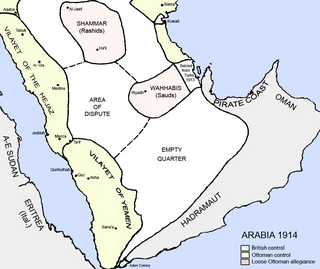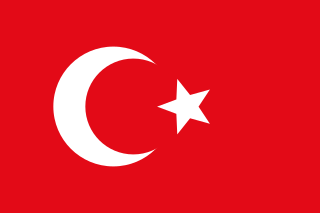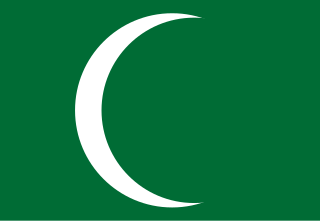 W
WThe Ottoman era in the history of Arabia lasted from 1517 to 1918. Ottoman degree of control over these lands varied over the four centuries with the fluctuating strength or weakness of the Empire's central authority.
 W
WThe Royal Family of Al-Sulaim is the dynasty that has sat on the throne of Unaizah in Saudi Arabia since 1817. They became the rulers after prince Yahia bin Sulaim (1817–1836) killed the governor appointed by the Ottomans. Prince Yahia continued to govern the state until he was killed in the battle of Bag’a with bin Al Rashid of Ha'il.
 W
WThe Idrisid Emirate of Asir was a state located on the Arabian Peninsula. The Emirate was located in the geographical region of Jizan in what is now southwestern Saudi Arabia. The authority of the Emir was restricted to a strip of the Tihamah some 80 mi (129 km) long and extending about 40 mi (64 km) inland to the scarp of highland Asir, with Sabya as its capital and Jizan and Midi as ports.
 W
WBattle of Shinanah was a major battle of the Saudi–Rashidi War, during the Unification of Saudi Arabia campaign, between Rashidi and Saudi rebels. It occurred on 29 September 1904, in town of Shinanah in Qassim region. After Ibn Saud victory in Battle of Bekeriyah, Ibn Saud planned to conquer the whole Qassim region. Ibn Rashid also planned to regain control on the region. The battle ended with Saudi victory, Ibn Saud gained thousands of the remains Turkish supplies in the town, Ibn Rashid and his Ottoman allies forced to move back to Rawdat Muhanna.
 W
WThe Battle of Unaizah took place during the early stage of the Saudi-Rashidi War. Abdul Aziz captured Unaizah (Anaiza) in March 1904, killing 370 while losing only two men.
 W
WDiriyah, formerly romanized as Dereyeh and Dariyya, is a town in Saudi Arabia located on the north-western outskirts of the Saudi capital, Riyadh. Diriyah was the original home of the Saudi royal family, and served as the capital of the Emirate of Diriyah under the first Saudi dynasty from 1744 to 1818. Today, the town is the seat of the Diriyah Governorate, which also includes the villages of Uyayna, Jubayla, and Al-Ammariyyah, among others, and is part of Ar Riyad Province.
 W
WThe Emirate of Diriyah, also transliterated as the Emirate of Dir'iyah, and known as the First Saudi State, was established in the year 1744 when Muhammad ibn Abd al-Wahhab and Prince Muhammad bin Saud formed an alliance to found a socio-religious reform movement to unify the many states of the Arabian Peninsula. In 1744, both Muhammed bin Abd Al Wahhab and Muhammad bin Saud took an oath to achieve their goal. Marriage between Muhammad bin Saud's son, Abdul-Aziz bin Muhammad, and the daughter of Muhammad ibn Abd al-Wahhab helped to seal the pact between their families which has lasted through the centuries to the present day.
 W
WThe Emirate of Jabal Shammar, also known as the Emirate of Haʾil or the Rashidi Emirate, was a state in the northern part of the Arabian Peninsula, including at Najd, existing from the mid-nineteenth century to 1921. Jabal Shammar in English is translated as the "Mountain of the Shammar". Jabal Shammar's capital was Ha'il. It was led by a monarchy of the Rashidi dynasty. It included parts of modern-day Saudi Arabia, Iraq, Kuwait, and Jordan.
 W
WThe Emirate of Nejd and Hasa was a state that existed from 1913 to 1921. It was a monarchy led by the House of Saud. The state was formed after Saudi forces seized Al-Ahsa from the control of the Ottoman garrison, during the Conquest of al-Hasa. It is a direct antecedent of the Sultanate of Nejd.
 W
WThe Emirate of Riyadh. was the first iteration of the third Saudi state from 1902 to 1913. It was a monarchy led by the House of Saud. The state was formed after Saudi forces seized Riyadh from the control of the Emirate of Ha'il, led by the House of Rashid, during the Battle of Riyadh. It is a direct antecedent of the Emirate of Nejd and Hasa. Al-Hasa was conquered in 1913.
 W
WHabesh Eyalet was an Ottoman eyalet. It was also known as the Eyalet of Jeddah and Habesh, as Jeddah was its chief town, and Habesh and Hejaz. It extended on the areas of coastal Hejaz and Northeast Africa that border the Red Sea basin. On the Northeast Africa littoral, the eyalet comprised Massawa, Hirgigo, Suakin and their hinterlands.
 W
WThe Hejaz Expeditionary Force of the Ottoman Empire was one of the expeditionary forces of the military of the Ottoman Empire. Its commander had the authority of an army commander. It was formed during World War I for the defense of Medina.
 W
WThe Vilayet of the Hejaz refers to the Hejaz region of Arabia when it was administered as a first-level province (vilayet) of the Ottoman Empire. At the beginning of the 20th century, it reportedly had an area of 96,500 square miles (250,000 km2). The Hejaz included all land from the southern border of the Vilayet of Syria, south of the city of Ma‛an, to the northern border of the Vilayet of Yemen, north of the city of Al Lith.
 W
WHussein bin Ali Al-Hashimi was an Arab leader from the Banu Hashim clan who was the Sharif and Emir of Mecca from 1908 and, after proclaiming the Great Arab Revolt against the Ottoman Empire, King of the Hejaz from 1916 to 1924. At the end of his reign he also briefly laid claim to the office of Caliph. He was a 37th-generation direct descendant of Muhammad, as he belongs to the Hashemite family.
 W
WThe Masmak Fort, also called the Masmak Fortress or Masmak Palace, is a clay and mudbrick fort in the old city of Riyadh, situated in the modern-day Deira district. Built in 1865 by 'Abdurrahman ibn Sulaiman under the Emirate of Jabal Shammar, The fortress played an integral role in the Unification of Saudi Arabia, with the Battle of Riyadh, one of the most important conflicts of the Saudi unification, taking place in the fort. Since 1995, the fortress has been converted into a museum showcasing one of the most important landmarks of Saudi heritage.
 W
WAbdulaziz bin Mithab better known as Ibn Rashid, was the Emir of Jabal Shammar from 1897 to 1906. A son of the third Rashidi emir, he was adopted by his uncle Mohammed, the fifth emir, and brought up to be his heir. After Mohammed died of natural causes, Abdulaziz succeeded him unopposed. However, the Rashidi rule was insecure, as their Ottoman allies were unpopular and weakening. In 1902 Ibn Saud, the founder of Saudi Arabia, returned from Kuwait with a small force and retook Riyadh. Abdulaziz died in the battle of Rawdat Muhanna with Ibn Saud in 1906 after several other battles with Saudis.
 W
WThe sanjak of Najd was a sanjak of the Ottoman Empire. The name is considered misleading, as it covered the al-Hasa region, rather than the much larger Najd region. It was part of Baghdad Vilayet from June 1871 to 1875, when it became part of the Basra Vilayet.
 W
WThe Emirate of Nejd was the second Saudi state, existing between 1824 and 1891 in Nejd, the regions of Riyadh and Ha'il of what is now Saudi Arabia. Saudi rule was restored to central and eastern Arabia after the Emirate of Diriyah, the First Saudi State, having previously been brought down by the Ottoman Empire's Egypt Eyalet in the Ottoman–Wahhabi War (1811–1818).
 W
WSaʿūd bin ʿAbd al-ʿAzīz Al Rashid was the tenth Emir of Jabal Shammar. His parents were Abdulaziz bin Mutib and Fatima Al Zamil.
 W
WThe Sheikdom of Upper Asir was an Arab state which was established in August 1916, after it broke away from the Idrisid Emirate of Asir. It was led by Al-Hasan Bin Ayad. It became a protectorate of the Kingdom of Hejaz in 1920. The region was occupied and annexed by the Sultanate of Nejd in 1923, which would later become modern-day Saudi Arabia.